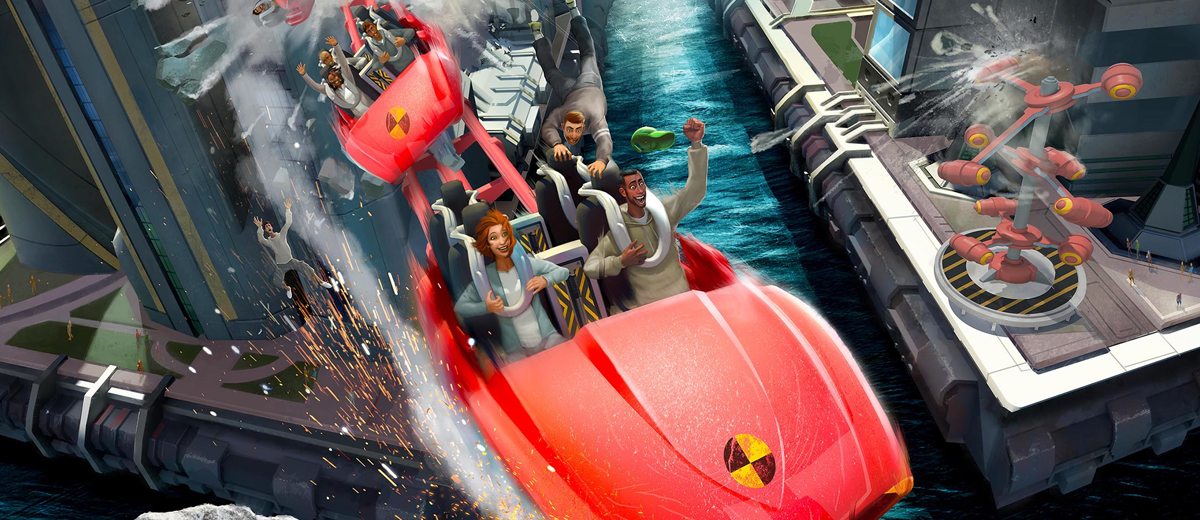 NOTE: This review is applicable to the Xbox One version of ScreamRide. This review may not be a 100% accurate in regards to the Xbox 360 version, due to technical disparities and missing features.
NOTE: This review is applicable to the Xbox One version of ScreamRide. This review may not be a 100% accurate in regards to the Xbox 360 version, due to technical disparities and missing features.

Our near-future society is in dire need of the impossible. People are disenchanted and bored with merely virtual satisfaction. Recent years have seen humans indulge in ever more extreme pastimes to feel alive.
However, there is an organization looking to bring easily extreme experiences closer to society than it has ever been. Far off our familiar shores, away from prying eyes, is the ScreamWorks International Research Facility. On their floating, man-made islands, ScreamWorks is developing a class of rides no simple theme park could dream of.
ScreamWorks future aim is to deliver danger on tap, on our doorsteps, and snaking up our office blocks. Whenever we want it, the ultimate of adrenaline rides will be just around the corner.
For now this is pure science-fiction, but out here, in the deep ocean, creativity and engineering are smashing boundaries. Understanding the science of terror and the limits of destruction is precisely why you are here—To build higher, hit harder, and scream louder.
THIS IS SCREAMRIDE.
 Visually ScreamRide applies a cartoonish art style akin to one of Frontier’s earlier titles; Thrillville. Set on the grounds of various futuristic testing facilities, most of ScreamRides models and texture are structured in a fairly simple manner, with materials consisting out of white building blocks, glass, steel and a handful of other materials. Most textures aren’t too detailed due to the specific artstyle, but from a technical standpoint there weren’t any surfaces or models that stood out for being less detailed or visually effective.
Visually ScreamRide applies a cartoonish art style akin to one of Frontier’s earlier titles; Thrillville. Set on the grounds of various futuristic testing facilities, most of ScreamRides models and texture are structured in a fairly simple manner, with materials consisting out of white building blocks, glass, steel and a handful of other materials. Most textures aren’t too detailed due to the specific artstyle, but from a technical standpoint there weren’t any surfaces or models that stood out for being less detailed or visually effective.
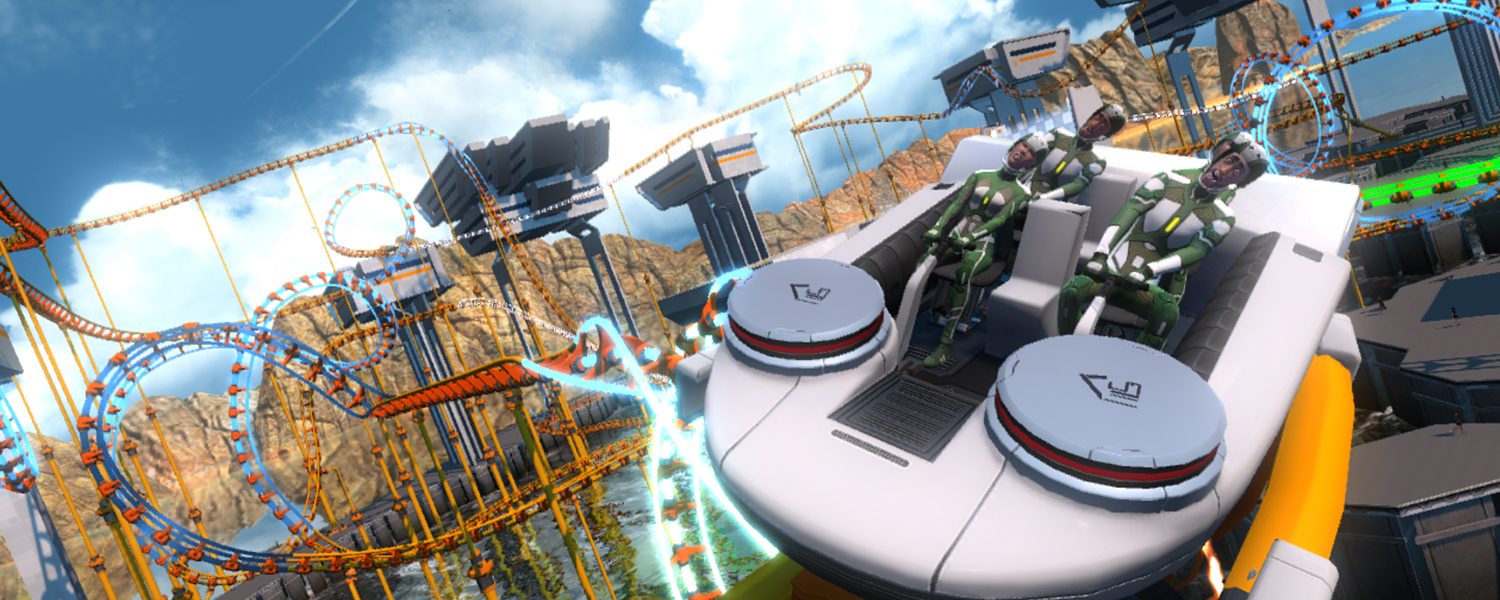 There isn’t anything particularly impressive about the basic visuals of ScreamRide, but the basic fact is that it all just works, and considering the theme and purpose of the gameplay mechanics they’re quite fitting, due to the fact that you’re throwing around riders a lot of the time, which seems a lot less jarring due to the fact that they’re cartoon characters, and the rules of ScreamRide’s physics compensate for any graphic visuals that you’d get from the physical torments the AI characters go through. The game is composed of a vivid color scheme, in a similar fashion to Sunset Overdrive’s visuals, albeit the variety in color is a bit more limited due to the limited amount of material designs and environments. The visual composition as a whole isn’t extravagant or anything, but it does the job and compliments the game quite well.
There isn’t anything particularly impressive about the basic visuals of ScreamRide, but the basic fact is that it all just works, and considering the theme and purpose of the gameplay mechanics they’re quite fitting, due to the fact that you’re throwing around riders a lot of the time, which seems a lot less jarring due to the fact that they’re cartoon characters, and the rules of ScreamRide’s physics compensate for any graphic visuals that you’d get from the physical torments the AI characters go through. The game is composed of a vivid color scheme, in a similar fashion to Sunset Overdrive’s visuals, albeit the variety in color is a bit more limited due to the limited amount of material designs and environments. The visual composition as a whole isn’t extravagant or anything, but it does the job and compliments the game quite well.
An issue with the overall presentation of ScreamRide is the fact that it re-uses the Portal-esque testing facility concept, including an AI that will either compliment or talk you down depending on your results. Whilst this setting is an effective fix for the morality issues when basing an entire game around crashing theme park rides, but the resemblance is a little uncanny at certain points of the game. I wouldn’t call this a big issue, or even an issue for some at all, but I found this to be a relevant point whilst analysing the game’s presentation.
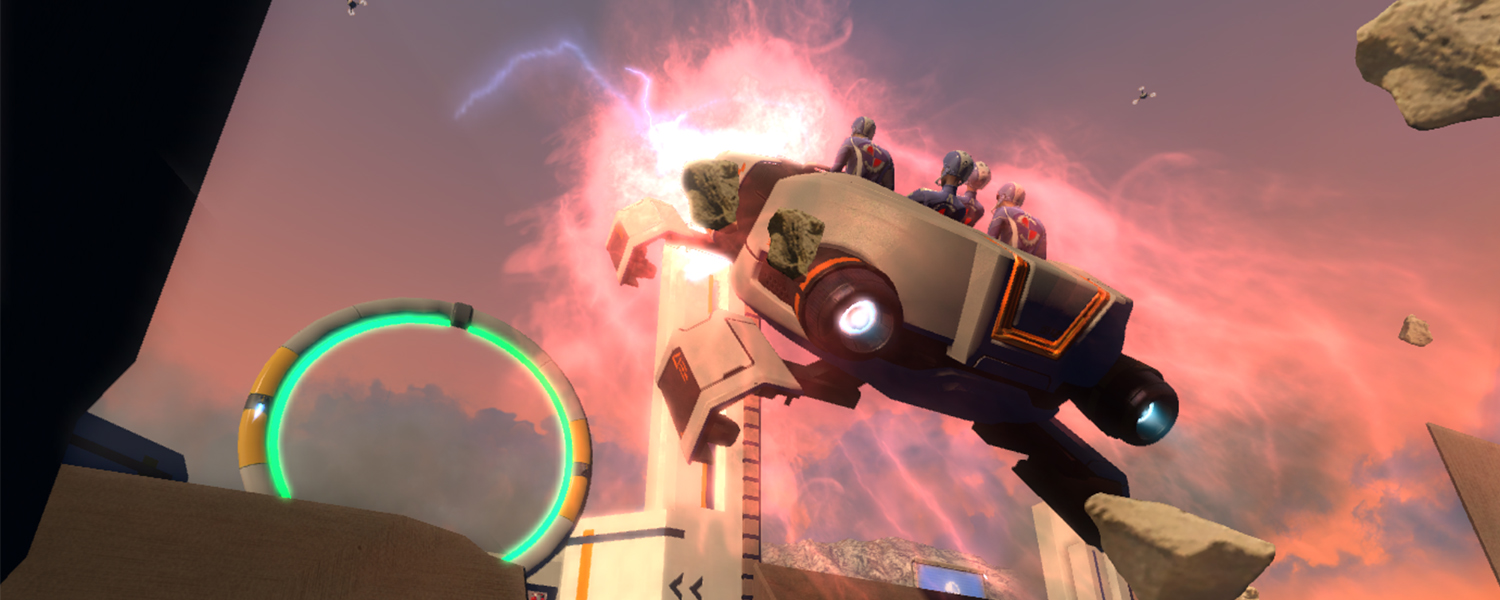
One of ScreamRide’s most notable visual features is the sheer amount of visual destruction, which is impressive, even though a lot of the debris is composed of simplified items. Crashing a coaster or ride vehicle into a building is a simple delight to see, and when you add explosions to the mix, a visual spectacle of chaos follows. However, the frame rate does seem to suffer quite a bit when certain mechanics are applied. Whilst riding coasters, building and launching vehicles into the sky didn’t do much to affect the frame rate, it did seem to take quite a few drastic dips during destruction sequences and re-constructing the levels. These dips weren’t quite that subtle, and the engine did seem overly stressed during these moments. Whilst the advanced nature of the environments of ScreamRide are a clear explanation of these issues, I did find these drops quite distracting, though it’s unclear wether this is due to hardware limitations or programming faults on Frontier’s end.
ScreamRide’s soundtrack consists of a collection of original electronic songs that fit well with the futuristic setting of the game. The song selection is decent, and due to the nature of the symphonies you won’t find yourself being too bothered by repeat performances. That being said, as well-made as the soundtrack is, ScreamRide should be a good contender for playing your own music throughout your gameplay sessions, which I did find myself doing after the first hour or so.
 Crashing rides and coasters has always been a habit of Rollercoaster Tycoon players throughout its history, and Frontier has decided to take advantage of these habits, and create a game that focusses solely on this aspect, leaving out the strategy and logistics of running actual theme park facilities. The game consists of 3 basic concepts; riding, building and demolishing. The game is divided into six sectors, with each sector consisting of a small selection of levels of each game mode. In order to move through each sector you’ll have to finish the levels and their main objectives, along with the optional side objectives should you want to perfect your results.
Crashing rides and coasters has always been a habit of Rollercoaster Tycoon players throughout its history, and Frontier has decided to take advantage of these habits, and create a game that focusses solely on this aspect, leaving out the strategy and logistics of running actual theme park facilities. The game consists of 3 basic concepts; riding, building and demolishing. The game is divided into six sectors, with each sector consisting of a small selection of levels of each game mode. In order to move through each sector you’ll have to finish the levels and their main objectives, along with the optional side objectives should you want to perfect your results.
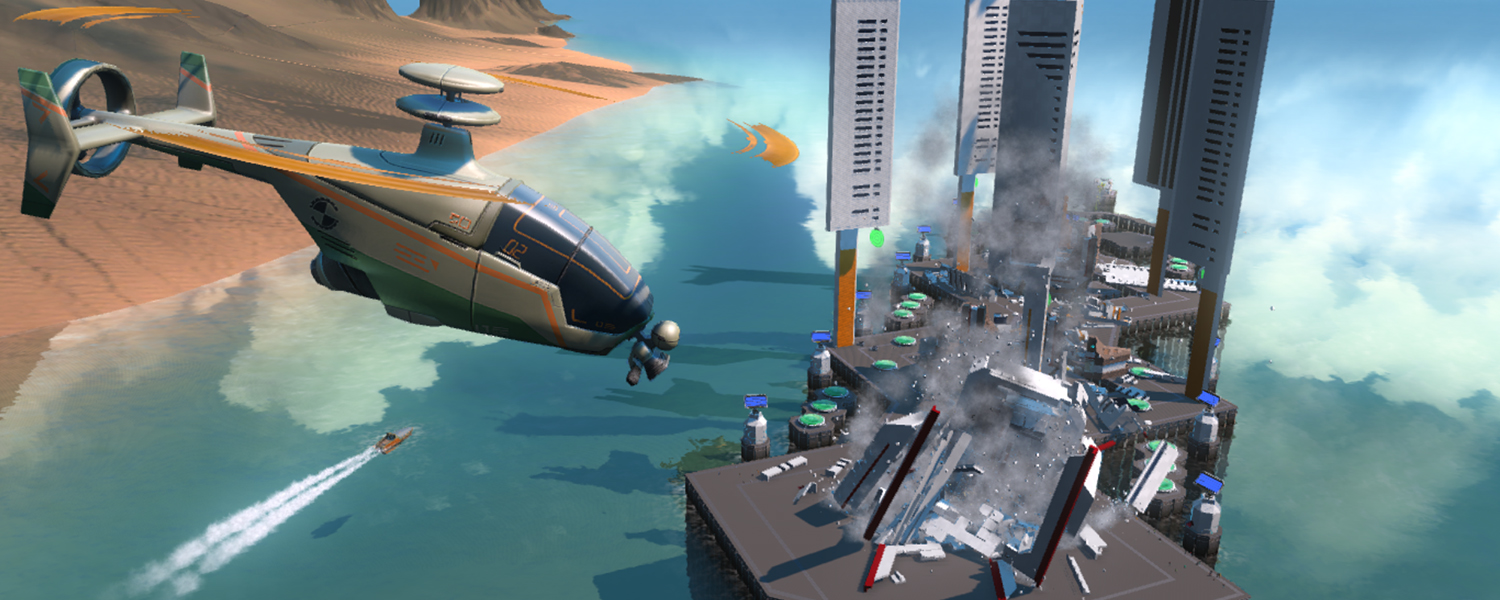 The first of the three game modes is ScreamRider, which has players dodge obstacles and try to remain on track, completing the circuit and performing stunts in order to reach a high as possible score. Due to the fact that the coaster trains aren’t as locked to the track as your additional coaster, the player has to adjust their speeds, lean in the right direction with the right stick and collect turbo charges in order to move through the circuit as fast as possible without losing any riders. When you leave the track by accident you’ll be respawned at an earlier point in the circuit, but often you’ll find yourself restarting the entire level due to the fact that this does reflect on your final score. ScreamRide is pretty fun for the first initial few levels, but the more you play it, the more it feels like ScreamRider was the last section of the game Frontier payed attention to, due to the fact that it feels like an afterthought. For what it is, ScreamRider may provide some enjoyment in short bursts.
The first of the three game modes is ScreamRider, which has players dodge obstacles and try to remain on track, completing the circuit and performing stunts in order to reach a high as possible score. Due to the fact that the coaster trains aren’t as locked to the track as your additional coaster, the player has to adjust their speeds, lean in the right direction with the right stick and collect turbo charges in order to move through the circuit as fast as possible without losing any riders. When you leave the track by accident you’ll be respawned at an earlier point in the circuit, but often you’ll find yourself restarting the entire level due to the fact that this does reflect on your final score. ScreamRide is pretty fun for the first initial few levels, but the more you play it, the more it feels like ScreamRider was the last section of the game Frontier payed attention to, due to the fact that it feels like an afterthought. For what it is, ScreamRider may provide some enjoyment in short bursts.
The second, and much more enjoyable game mode is “Demolition”, in which players unleash their primal instincts and launch pods and coaster cars into the air to destroy structures around the map. The player is given multiple types of pods and cars that each have their own special feature, which vary from gliding and rockets to explosive charges, which help you cause even more destruction. Whilst the basic concept of Demolition is pretty simple, the destruction is what easily makes it the best mode of the game. Launching your pod onto the map isn’t as easy as you’d think, as you have to time your throw at a specific time in the rotation to reach your goal. You can slow down time and get an additional aiming line to aim more precisely, but for those who want a bigger challenge doing your throws at full speed is actually pretty redeeming if your throw works out.
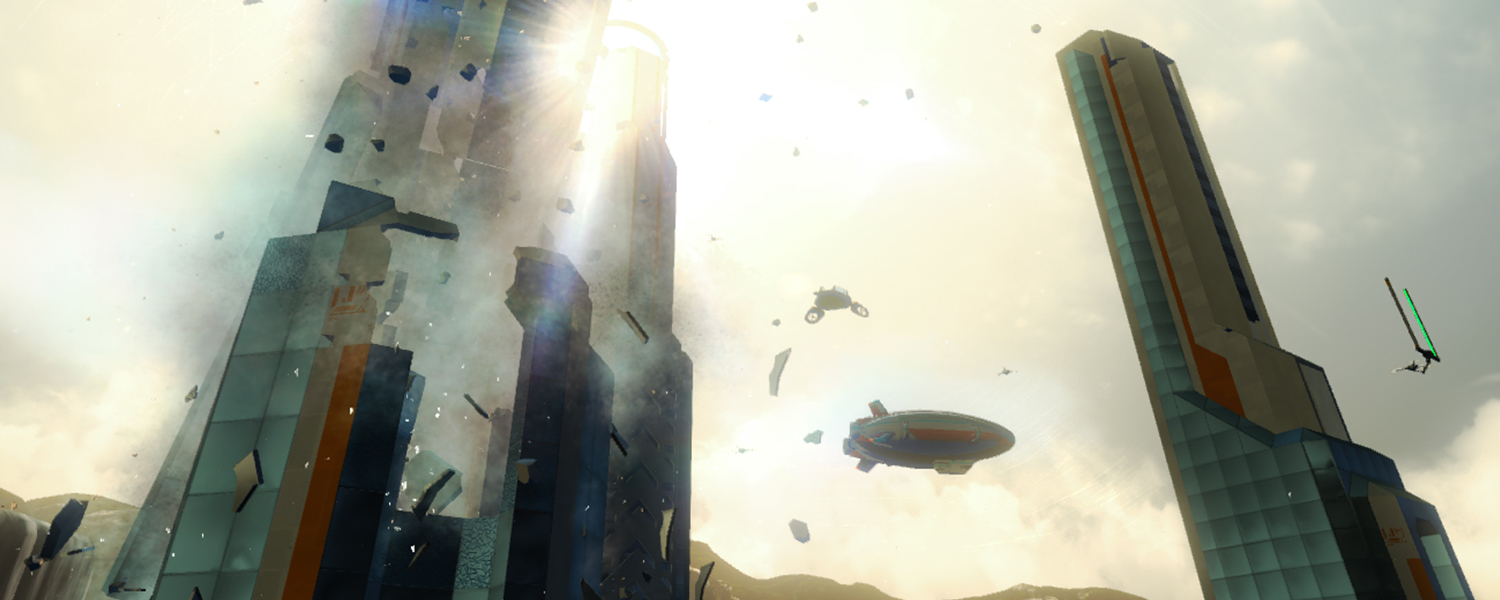 Third, but not least is the Engineer mode, which has you unleash your creativity in order to create the most thrilling and death-defying coasters. Frontier has built upon their experience with the genre to create a pretty deep construction mechanic, which is surprisingly flexible in use. Players can use the buttons and sticks to adjust the directions and banks of the track, but you can also open your options by using the right stick by itself to provide a more flexible manner of construction, which is welcome considering you can get stuck at certain points if you’re constructing your coaster on close quarters, which the game often asks of you. Once you finish your coaster, the game will simulate the ride and give you the results, which sometimes send you back to the drawing board due to the fact that the train may either not to able to finish the course, or is simply launched off into oblivion by derailing. Engineer is the second-most captivating mode of ScreamRide, but it’s also the biggest case of trial-and-error, considering you can be testing out your tracks multiple times, either because the track couldn’t be completed, or you didn’t meet the standards the specific level asked of you.
Third, but not least is the Engineer mode, which has you unleash your creativity in order to create the most thrilling and death-defying coasters. Frontier has built upon their experience with the genre to create a pretty deep construction mechanic, which is surprisingly flexible in use. Players can use the buttons and sticks to adjust the directions and banks of the track, but you can also open your options by using the right stick by itself to provide a more flexible manner of construction, which is welcome considering you can get stuck at certain points if you’re constructing your coaster on close quarters, which the game often asks of you. Once you finish your coaster, the game will simulate the ride and give you the results, which sometimes send you back to the drawing board due to the fact that the train may either not to able to finish the course, or is simply launched off into oblivion by derailing. Engineer is the second-most captivating mode of ScreamRide, but it’s also the biggest case of trial-and-error, considering you can be testing out your tracks multiple times, either because the track couldn’t be completed, or you didn’t meet the standards the specific level asked of you.
Whilst the main campaigns of the game are quite limited in length, users interested in custom content can unleash and share their imagination by creating custom levels. The sandbox mode gives you the ability to use all of your unlocked content to create levels with custom tracks, structures and objectives, which lengthen the game by quite a bit, but only if you’re interested in either building or downloading custom content. Sandbox mode is quite extensive, and in some ways it’s the saving grace of a game that really consists of a very small amount of content considering the pricing.
*NOTE: Whilst sandbox mode is available on both versions of the game, sharing features are not available on the Xbox 360.



